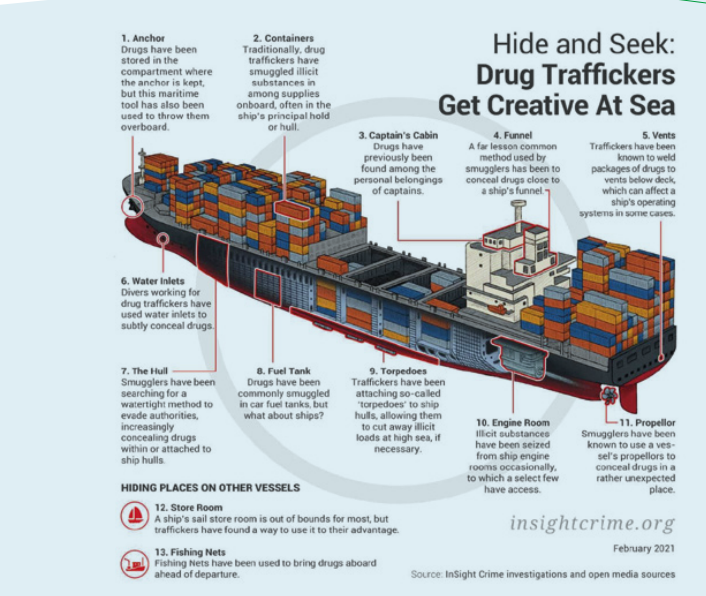Britannia published a circular from Brazil P&I, which highlights that the modus operandi of drug traffickers is almost the same in different ports. Especially, drug traffickers use Brazil for its strategic location in South America, wide coastline, and many ports to transport illegal narcotics to European, North American, and other markets.
The most common strategies or methods used by them are:
Introduce bags with drugs in the sea chests or attach them to the hull, rudders, anchors, propellers, and vents of the vessel using divers while the ship is docked or at anchor. Hiding relatively small amounts of drugs in remote locations on board (e.g. cabins, funnels, decks, storerooms or engine rooms). Place illegal substances inside sealed containers before loading.
One of the most common methods currently used by drug traffickers is to break container seals and hide drugs inside the cargo, replacing the seals ( this method involves some level of collaboration from terminal operators or freight forwarders). In this case, refrigerators are the most often used. Burying packages of drugs inside the bulk cargo. This method allows large amounts of illegal substances to shift at any time, usually within the cargo.
Especially in the Port of Santos, with an anchorage area out of the Port, small boats can approach the ships that are in the anchorage. The same can happen with ships moored in the port, which due to their size and geographical characteristics with very small auxiliary waterways, turn it difficult for the police to monitor activities in the port channel.
Where traffickers hide drugs?
#1 Anchor: Drugs have been stored in the compartment where the anchor is kept, but this maritime tool has also been used to throw them overboard.
#2 Containers: Traditionally, drug traffickers have smuggled illicit substances in among supplies onboard, often in the ship’s principal hold or hull.
#3 Captain’s Cabin: Drugs have previously been found among the personal belongings of captains.
#4 Funnel: A far lesson common method used by smugglers has been to conceal drugs close to a ship’s funnel.
#5 Vents: Traffickers have been known to weld packages of drugs to vents below deck which can affect a ship’s operating systems in some cases.
#6 Water Inlets: Divers working for drug traffickers have used water inlets to subtly conceal drugs.
#7 The Hull: Smugglers have been searching for a watertight method to evade authorities, increasingly concealing drugs within or attached to ship hulls.
#8 Fuel Tank: Drugs have been commonly smuggled in car fuel tanks, but what about ships?
#9 Torpedoes: Traffickers have been attaching so-called “torpedoes” to ship hulls allowing them to cut away illicit loads at high sea, if necessary.
#10 Engine Room: Illicit substances have been seized from ship engine rooms occasionally, to which a select few have access.
#11 Propellor: Smugglers have been known to use a vessel’s propellors to conceal drugs in a rather unexpected place.


































































